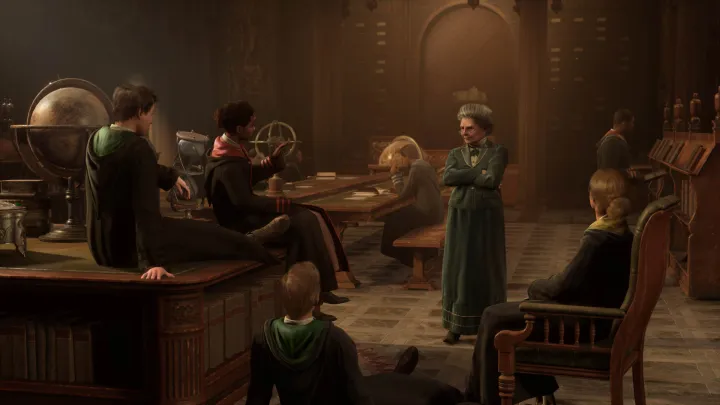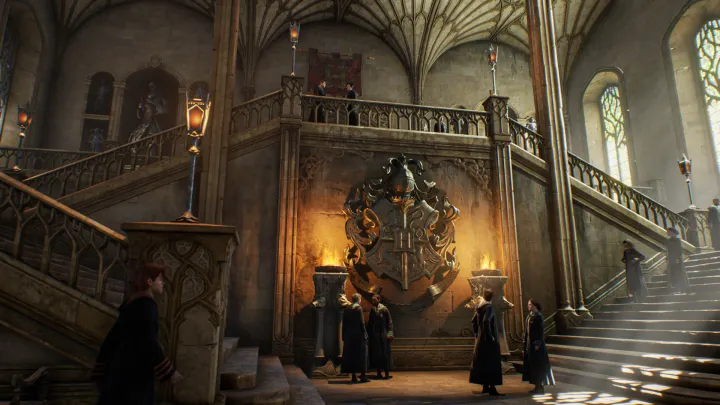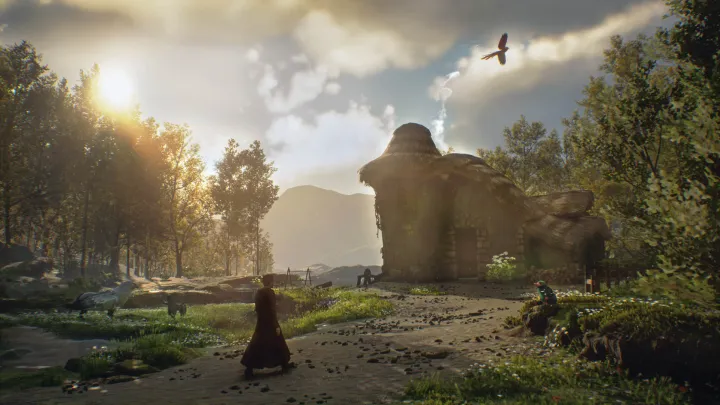
“Hogwarts Legacy will likely please die-hard Harry Potter fans, but its tired open-world design lacks imagination.”
- Hogwarts is a design marvel
- Flying is magical
- Great environmental puzzling
- Lots of spells to experiment with
- Nonsensical story
- Uninspired gameplay
- Drab open-world design
- Repetitive combat
Despite being a 30-something who grew up during the golden age of Harry Potter, Hogwarts Legacy managed to be my first real exposure to the Wizarding World. Though if I’m being honest, it’s not quite the magical first introduction I always pictured it would be.
For some of the series’ most die-hard loyalists, I’m sure Hogwarts Legacy will be a dream come true. The glitzy open-world adventure game goes to painstaking lengths to bring the franchise to life. Every corner of it is stuffed with some visual reference or lore tidbit for fans to pore over as they finally get their chance to role-play as a Hogwarts student. Looking in as an outsider, though, I can’t help but feel like developer Avalanche Software has cast an effective illusory spell. Strip away all those aesthetic trappings like wallpaper from your childhood bedroom and you’ll find something cold and clinical cleverly disguised by warm nostalgia.
Hogwarts Legacy delivers a perfectly competent adventure, but its most unforgivable curse is its lack of imagination. Despite having access to an entire universe of possibilities, its sole trick is using magic to cover up tired video game clichés that feel entirely disconnected from the vibrant source material it’s adapting. The only unique aspect it brings to the open-world genre is franchise branding, making for a shallow experience that doesn’t offer much more than wish fulfillment for fans unable to let go of a dream.
Goblins, rise up
If you’ve ever found yourself fantasizing about being whisked away to Wizard school as a kid, Hogwarts Legacy grants that wish. Set in the 1800s, the story focuses on a generic fifth-year student who’s tasked with taking down a brewing Goblin rebellion in-between their school duties. That perfect premise is the first area where some expectation setting becomes necessary. There’s not much depth to the education aspect here as “classes” only play out as 12 checklist-driven subquests, each of which rewards a new spell for completing some challenges while out in the world.

It’s the first clue that Hogwarts Legacy doesn’t have a lot of ideas about how to make Harry Potter feel special in a video game. There are no shortage of ways to think outside the box when crafting a “school” premise. The Persona series uses daily routines to emulate the experience of studying for midterms by day and tormenting perverts by night. Fire Emblem: Three Houses uses classes to motivate its RPG hooks, giving players a narrative justification for why their troops grow smarter and stronger through the tactics game. Even Pokémon Scarlet and Violet gets clever with an independent study setup that shakes up an old series’ formula. Rather than putting its own unique stamp on the idea, Hogwarts Legacy simply uses its premise as a means to pepper in a dozen quests. Though, to its credit, they certainly feel about as fun to complete as homework.
The story outside of Hogwarts has its own struggles with creativity. Prior to launch, the Goblin storyline was subject to tremendous scrutiny. The greedy, “hook-nosed” creatures have long been called out as a crass Jewish caricature and the idea of squashing their attempt at independence seemed like a tone-deaf decision on paper. In reality, there’s not much to get heated about; the story and its characters are too thin to warrant a fuss. Perhaps careful to steer clear of author J. K. Rowling’s tasteless depiction, the Goblins of Hogwarts Legacy may as well be orcs visiting from Middle-earth. Their motives are barely fleshed out, and they’re largely there to populate combat encounters. Any empathy gets buried in a sea of historical worldbuilding dumped out of lifeless NPCs.

As a newcomer, one passing scene did manage to snag my attention. Midway through the story, I learn that the Goblins have a chip on their shoulder because Wizards have decided to hoard magic to themselves, leaving the race to suffer. Seems reasonable enough to me. For a moment, I’m convinced the story must be building toward a Last of Us-style twist where I learn the institution I’m beholden to is the real big bad. Though I do get an eventual attempt at nuance, it doesn’t stop the story’s hero from melting countless Goblins with fire spells while proclaiming that it’s too late to rehabilitate them.
That’s where J. K. Rowling herself, the author with a history of making transphobic comments and who stands to profit from the game’s success, comes into play. Avalanche has clearly tried to distance itself from Rowling’s hateful remarks, going as far as to allow players to create a transgender hero. Though in staying true to the franchise’s rich mythology, the narrative is ultimately still at the mercy of the author’s worldview. The Goblin story never gains ground as a guiding conflict because it never really makes sense. The universe’s uneven power structures beg for some scrutiny, but the books dictate that we don’t really question the inner politics of the Wizarding World. Wizards are largely good. Goblins are unredeemable monsters, unless they’re running a bank.
Hogwarts Legacy softens Rowling’s writing as much as it can, but that’s only half a solution. You can’t get rid of a worldview without offering one of your own.
Hogwarts Legacy doesn’t believe in anything, and its frequently illogical story reflects that reality.
That decision leads to story beats that often come across as downright nonsensical. In the game’s most head-scratching mission, I’m tasked with saving animals freely roaming Hogwarts because poachers are on the prowl. To do that, I need to sneak up on them as they hang out in their habitat and suck them into a magical bag as they struggle to escape. I then take them back to my own personal zoo, where I’m able to harvest valuable resources from them. I quite literally “rescue” them from the existential threat of poaching by actually poaching them. In another subquest later on, a woman tells me she wants me to hunt down a pet bird because its feathers are valuable, which prompts me to question if she’s treating the animal correctly.
Moments like that are indicative of the entire story, a flat adventure punctuated with convoluted contradictions. When I’m introduced to Unforgivable Curses, I’m told that it’s a dark practice that I should never utilize. Moments later, I’m using it to paralyze random wolves prowling the world with no consequence. Even beyond that, I’m never fully able to get over the fact that I’m a young kid wandering into poacher camps, burning human beings alive with magic as they scream in agony, and continuing on with my journey while whimsical children’s music plays.
At least Rowling is consistent: Her deplorable views always make it clear where she stands. It’s not surprising when her writing edges into hateful stereotypes. Hogwarts Legacy doesn’t believe in anything, and its frequently illogical story reflects that reality too.
Open-world chores
Though some players may be able to push the hazy narrative aside, the actual gameplay doesn’t exactly thrill either. Avalanche plays it safe here, creating a boilerplate AAA open-world action-adventure game dressed up in a scarf and glasses. It’s a basic approach that checks all the boxes, fitting in as many genre tropes as it can. A map littered with markers to obsessively chase? Check. Outposts full of enemies to clear out? You bet. Fetch quests, collectibles, skill trees, crafting … name any old standard you’d find in an Assassin’s Creed game and you’ll see it represented in some form here.
Hogwarts itself [is] a triumphant piece of level design.
Hogwarts Legacy doesn’t do anything particularly wrong here. Most of its ideas are executed well enough, albeit in paint-by-numbers fashion. The issue, however, is its lack of a “hero” feature. A lot of open-world games cut from this template are functionally identical, shuffling the same gameplay hooks around. The best ones, however, add something new to the equation that can make well-trodden territory feel fresh again. The Witcher 3: Wild Hunt excels in its engrossing writing, Marvel’s Spider-Man features best-in-class traversal, and Horizon Forbidden West sports a complex combat system that’s unlike anything else on the market today. There’s little I can point to that makes Hogwarts Legacy stand out aside from the IP attached to it.
The one area where Avalanche is able to leverage that selling point to create something special is in Hogwarts itself, which is a triumphant piece of level design. The richly detailed school is enormous, almost acting as its own self-contained, interior open world. After 25 hours, I was still discovering entire sections I’d never seen before, not to mention its myriad of hidden passages that lead to side dungeons. It’s an endless labyrinth loaded with genuine mystery and tons of fan service that almost transforms it into a digital museum for the wider series. Most of the legitimate fun I experienced during my playthrough simply came from getting lost and suddenly wandering into a music room filled with singing frogs and dancing instruments. All of Hogwarts Legacy’s best worldbuilding happens in those little Easter eggs, not its long-winded exposition dumps.

The land outside of Hogwarts isn’t nearly as enthralling. The traditional open world is devoid of personality, indistinguishable from something you’d see in The Witcher. It’s a fairly nondescript collection of forests and cliffsides with a random house or two thrown in for looting purposes. I often find myself asking “have I been here before?” as I cut through a patch of randomly placed shacks that leave me with a serious case of déjà vu. It doesn’t help that everything is rendered in an oddly drab visual style that bathes the entire world, interiors and exteriors alike, in an almost monotone shade of brown.
The dry design decision hurts one of the adventure’s standout features. The first time I take flight on my broomstick is a genuinely captivating moment (and my maiden voyage on a mount is even more astonishing). There’s an incredible sense of freedom and scale as I soar into the sky and finally get to see Hogwarts towering over the British countryside. That magic wears off a little when I’m simply passing over miles of generic forests, and it’s doubly lost when I bump into an invisible wall and am told I’m simply not allowed to fly through certain parts of the map. There’s never a reason for me to traverse it on foot either, as anything worth seeing exists as a marker on my map.

Partway through my playthrough, I began to wonder if Hogwarts Legacy was originally an entirely different game early in development that was forced to reduce its scope. It has the remnants of a live-service MMO baked into it. For instance, it features a poorly implemented gear system that has me equipping stat-based scarfs, hats, and more articles of clothing as if I’m dressing up a Destiny guardian. It’s as tedious as it is unnecessary, as a stingy inventory size (even after upgrades) means I’m constantly forced to scrap pieces of gear before I can sell them to a shop.
Other aspects of the game begin to make more sense when I look at it as an abandoned multiplayer experience. Hogwarts itself is oddly empty, with very few NPCs milling around its cavernous halls. I’m left to wonder if the original intent was for that space to be populated with other real players. Elsewhere, I’m able to fully customize my Room of Requirement as if it’s my Animal Crossing home, but a lack of multiplayer means I have no one to show it off to. Though a full-scale MMO may never have been in the cards, there’s something lonely about my time in the Wizarding World. I never feel like a student in a class so much as a lone drifter who’s just passing through.
Uneven spellcasting
The main problem that Hogwarts Legacy butts up against is a general lack of creativity — and that becomes apparent in the way it handles magic. By the end of my adventure, I have access to an impressively long list of spells that can be used to battle enemies and navigate the world. In its best implementation, the magic system makes for some strong puzzle-solving. Merlin trials, far and away the most engaging map activity in the open world, have me solving little environmental puzzles by using my spells. With no hints, I’m left to experiment around with my toolkit and learn all the ways my magic interacts with the world around me. It’s the only time I really feel like I’m connected to my surroundings, discovering the natural mysteries of nature with my own wit.
I very rarely feel like the game is working in service of the universe it’s representing; it’s the opposite.
Combat is much more of a mixed bag. My main offense is a single zapping spell that automatically targets nearby enemies (and sometimes snaps to environmental objects if I’m fighting near one). When I cast it, my character stops dead and stands still while attacking, creating a jerky pace with no fluidity. I can roll dodge, toss nearby objects, and shield myself from enemy attacks with Protego, but most of my skill set involves pulling the right trigger over and over until my finger hurts. That repetition is exacerbated by the fact that there are only a handful of enemy types in the game, which are repeated up until the final few bosses.
That move set is augmented with all of my additional spells, which I can execute on the fly by holding down R2 and pressing a face button. Those skills add some much needed variety and combo potential to an otherwise flat system. For instance, I can pull an enemy into the air with Levioso, drag them toward me with Accio, unleash Incendio when they’re in range, and then send them plummeting to the ground with Descendo. That system sings in short battles, where I can clean up a handful of Goblins in almost slapstick ways. Unfortunately, it all falls apart the bigger and longer a fight is. Boss battles especially drag, as a bulk of the spells simply have no effect on larger enemies. When that happens, I’m back to peppering bosses with weak shots and my few offense spells to whittle down a massive health bar.

It’s the much smaller uses of magic that disappoint me, though. Early in my adventure, I quickly learn that almost every spell is a stand-in for some video game trope. Revelio is the game’s own version of “Spidey-sense,” allows me to scan my surroundings for interaction points. In one mission, I use it to track a set of footprints, as I’ve done in almost every open-world game released in the past decade. Another spell grants me the power to essentially instant-kill an enemy when I sneak up on them in stealth — how magical!
The lack of creativity culminates in an incredibly small nitpick that speaks to a much larger criticism. Midway through the game, I learn Alohomora, a spell that unlocks doors. When I cast it, I’m suddenly thrust into a lockpicking minigame where I have to line up my joysticks in the right position. I don’t think much of it at first, as it’s another system I’m used to in games at this point. But the more I reflect on it, the more confused I am. Isn’t this spell supposed to unlock doors? Why would I need to physically pick the lock after casting it? Why wouldn’t I just use a lockpick if the magic doesn’t do the thing it’s supposed to do? Am I playing as myself in the minigame or as the spell itself as it tinkers? Whatever the mechanics of that interaction is, it doesn’t really feel like magic.

That small quirk represents an undercurrent of casual thoughtlessness that flows through Hogwarts Legacy. I very rarely feel like the game is working in service of the universe it’s representing; it’s the opposite. Harry Potter staples are retrofitted over open-world clichés, dressing up actions I’ve done countless times with a colorful flourish. I leave my experience feeling like I can better keep up with references to the series, but I’m not sure I’ve actually learned the language.
Though I’ve never read the books or seen the films, my outsider understanding was always that the Harry Potter franchise represented boundless imagination. That wondrous spirit is almost entirely absent from Hogwarts Legacy, a middle-of-the-road open-world game that doesn’t dare to think outside of the box. I’m left to wonder if this is truly the childhood fantasy fans always dreamed of or if it just looks like it through nostalgia-tinted spectacles.
Hogwarts Legacy was reviewed on PlayStation 5 hooked up to a TCL 6-Series R635.
Editors' Recommendations
- How to get the Finishing Touches achievement in Hogwarts Legacy
- Where to find mandrakes in Hogwarts Legacy
- All Daedalian Key locations in Hogwarts Legacy
- All Demiguise Statue locations in Hogwarts Legacy
- The best Mac games for 2023






